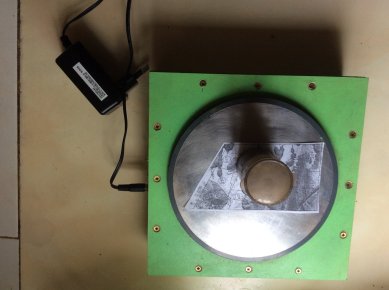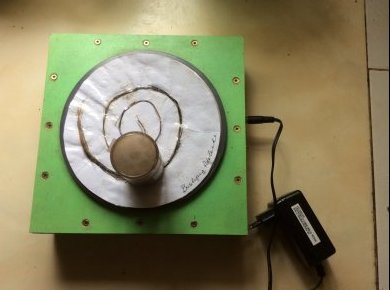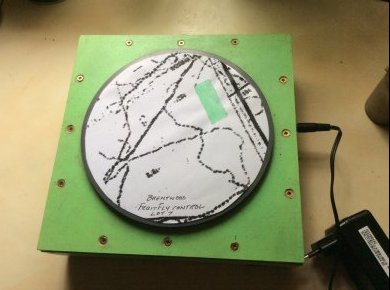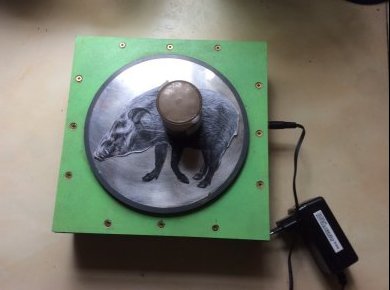DEVICES
This site describes two families of broadcast or often called radionic devices designed for gardening and agricultural use. Some models of broadcast plates are used extensively by homeopaths. Their application in farming and gardening requires the operator to give due consideration to all conditions, especially the class and health of soils, and the soil mineral balance.
Broadcast Towers: Devices used locally with a reach of up to several kilometers, depending on the size of the unit. Used to enhance plant growth, and to control predators in animal herds and damage to crops and pastures by animals, insects and pathogens. Allows multi-factor treatments.
Broadcast Plates: A non local device, with an infinite reach, giving a limited number of treatments to any location. Used to target small areas and individual subjects. Produced in a single and multi-plate units.
BROADCAST TOWERS
Assembly
These devices are very simple to assemble, consisting of a foot piece, a central spacer and an upper section. The lower section has a reagent vessel serving subsoil areas, and the upper section a reagent vessel serving the above soil areas, including foliar feeds ,insect deterrents, predator controls etc. Items common to both reagent vessels should be treated as such; as an example weeds (having aerial and sub soil components) or gerbils living in burrows and foraging on the surface.
The components should be positioned for assembly on a flat debris free surface. The T pieces should face in the same direction, the central green link wire should be joined and the pipe surfaces thoroughly cleaned with a PVC cleaner or benzene. The central section of plain pipe is then cemented using PVC weld into the respective T pieces. A rubber mallet should be used to ensure each join is driven to the correct depth in each T Piece.
On the indicated point a hole to 0,75m depth should be dug, wide enough to take the device and the supporting treated pole. A 4,2m pole is usually required. The foot of the device should be positioned on a 20mm thick soft sand cushion (high silica sand such as swimming pool filter sand is best). The lower section can also be placed inside a slightly larger pipe section say 1,2m long, having an internal diameter capable of accepting the collar dimension of the device. This facilitates the servicing and cleaning of the device. The pole, foot pipe, if installed, or a piece of irrigation pipe is then planted and the soil compacted. The assembled device is then placed into the foot pipe and cord, never wire, is used to lash the device to the pole. Failing the use of a foot pipe a 1,4 m section of 20/25/32mm LDPE irrigation pipe can be put into the hole to facilitate the maintenance of a moist contact zone on the earth plate.
A protective rope or pole fence made of wooden poles can be erected to prevent damage by game and cattle. In very windswept sites supporting guy ropes may be necessary. If lightning is a problem, a sturdy say 7.5sqmm copper wire should be stapled to the treated pole away from the device and led away to a 0,9m deep soak pit at least 2m away from the device.
Where high summer temperatures are experienced, these devices can be painted with a white high acrylic roof paint. All surfaces should be lightly sanded and cleaned prior to painting. Always avoid painting the access areas to the reagent vessels. Regular cleaning of the aerial plates to remove any bird excreta is necessary. Ensure that the reflecting aluminium sheet around each reagent vessel has not been damaged and the covering duct tape layer is sound.
Testing Routines
Each end of these devices can be tested to check the working of the relevant circuits. At each reagent vessel are two test points. A multi-tester set to the diode range is used to check the milli volt drop over the diode junction. Place the RED probe onto the reagent vessel test point and the BLACK probe on the test point on the inside of the vessel pipe section. The reading should range between 180-290 milli volts. If dampness is found in the interior of the device, holes can be drilled in the covering end caps of each reagent vessel. This will facilitate air movement and the drying out of the interior. Fine mesh can be cemented onto the insides of these end caps to prevent insect infestations.
The values of these tests will vary and rise as ambient temperatures fluctuate. Dampness in the interior of the device can result in high and erratic readings. Many devices are fitted with a breather vent just under the upper stop cap which serves as a base for the aerial plate or plates (in the case of a unit fitted with more than one upper inductor). Coupled with holes in the reagent vessel end stops, a constant cooling and drying air stream can be achieved.
Programming the Devices
Field broadcasters are primarily designed to enhance plant growth. As such both upper and lower reagent vessels should be filled with a weak solution of organic materials to enhance plant growth, together with any negative frequencies (peppering materials) of plants, insects, diseases, or animals which need to be retarded or removed from the treated area.
The efficacy of these mixes can be enhanced and matched to the needs of the farm by their conversion into a suitable receptor with a radionics device. It could also be mentioned that many insects can be controlled by manipulating the Brix count upwards which will raise the plants frequency, thus reducing insect attraction and attack. Basic details needed to ensure effective programming: pH, shortages or surpluses of major plant nutrients, and the status of trace elements. Each should be addressed to allow the broadcaster to re-balance the site, which in turn will enhance plant vitality and crop or pasture production.
In peppering weeds it is best to treat each individually by enhancing the negative frequency to the indicated level of potency for that particular farm. Similarly a given sought after species can be promoted by programming a positive frequency. In controlling predators and other unwanted animals, use local sources of material including locally dowsed rates. Always remember that animals and other life forms are continually adjusting their whole genetic being to meet the challenges of the day; this requires regularly replacing animal materials etc. The apparent cross-breeding behaviours of some species can be monitored and sampled to ensure acceptable control is achieved. Where necessary, all programming materials can be enhanced individually to ensure optimal performance on a radionics machine.
Limiting the reach of the devices: signals can be limited to specific areas by the use of a map or aerial photo of the targeted parts in each reagent vessel. Each map should include the owners desires and signature. An example would be to “treat only the areas outlined " and sign. Encapsulate the map in a laminating pouch as desired where aqueous solutions are used in the reagent vessels.
General Maintenance
Regular maintenance is essential. All glue lines, circuits, program materials and structural integrity must be checked. Tie lines to poles and guy-lines must replace as required. Sour aqueous solutions will be near useless and should be replaced with new or alternative materials. Unpainted PVC piping will become brittle with time and may need replacement. Following lightning activity in the area, these devices should be checked for obvious damage, including all circuits, and damage, if any, repaired. Earth plates should be kept moist at all times to ensure good conductance of ground oriented signals.
Remember when dowsing any parameter; ensure your mind is in Alpha mode and that your questions are specific, unambiguous and distinct. Always crosscheck and recheck dowsed values especially any outliers, as well as the acceptability of materials such as sugar pillules which have been potentised on a radionics machine.
BROADCAST PLATES
Historical Sketch
These techniques, which are daily becoming more important in farming and gardening, were developed from observations on human patients by an American neurologist, Dr Albert Abrams in the 1920's. Further developed by another American Dr Ruth Drown. The basic concept is that all objects and especially living organisms have a complex energy field, which must operate in an ordered manner for health and stability to result. These complex energy fields represent the exact correspondence to the physical body right down to the minutest detail. Such fields will reflect the status of nutrition, influence of pollution, climatic influences etc. Any detrimental conditions can be repaired, re-adjusted and relationships to environment or parent body restored. Early on in these developments, it was discovered that the signals arising from any condition are unique, and could be captured, transmitted and modified, and returned to the source. This ability has over the years, resulted in stepwise development to today's sophisticated digital devices.
A common non local device used on farms, and by homeopaths, and other exponents to treat a multitude of conditions is the broadcast plate. Use of these devices require a paired combination of witness (something to identify the patient or plant, soil, or other item to be treated) and a remedy. It also requires a positivism, optimism, a passion for a managerial objective. Emotional upheavals must be handled in a responsible manner.
Operation
The broadcast plate consists of a receiver plate, capable of capturing the inherent emissions from a witness/remedy combination. These frequencies are fed to a suitable oscillator which in turn feeds a transmitter system. This output signal will then seek the unique witness as defined by the receiver plate, and can be located anywhere. Once found, a resonance will occur and a start made in a restorative treatment.
Operational Detail
The broadcast plate is a non-local radionics device for the transmission of predetermined treatments to defined subjects or land areas. As the unit is designed to operate on the witness remedy principle, it requires a physical sample of the subject. This can take the form of a map(clearly outlined treatment area/s) signed on the back with the owners intention stated in a few words. Alternatively, a hair sample may be used, identified by placing the sample between two labels with the persons or animals identity or name. The hair should be not be dyed and free of any shampoo residues and can be taken from any part of the body of the person or animal. A further option is to use a photo of the person or animal, cutting out the face or head profile as witness. It should also be identified by name. Insects or hair samples can be arranged in a right hand spiral on a piece of clean paper; this has proved to be a powerful witness format. Essential to handle all witness materials with tweezers or forceps to prevent potential energy input from the operator. The remedy should be placed on top of the witness; this can take the form of a drug, homeopathic remedy, peppering materials or solutions or pillules onto which specific frequencies and related potencies have been loaded. Treatments should be compatible and are usually limited to three at any one time for a given witness. Broadcast times should be selected and set to match the problem, and seldom run longer than 12 hours per day. As an example: controlling baboons which are only active during daytime hours would require a map of the farm or land area with peppering materials in a suitable glass container on top. The unit would then be set to run with a timing device daily during daylight hours.
Local observers may find that the baboon troop or troops to be very active around sunrise and will require the timer to be reset to say a 14 hour day. Seasonal variation should also be considered and treatment discontinued as necessary. This will tend to enhance the remedy or treatment on the land. As another example, the treatment of an animal may require a daily dose of a drug or related frequency for 30 minutes. The timer is simply set for 30 minutes at the required time of day. The control of insect populations in the fruit industry will require a map of the orchard and a remedy timed according to the life cycle of the species and current state of development of the population. A continuous month long treatment may be necessary, and may require careful timing while workers are busy in the area. The device should be switched off during orchard activities should a potentially toxic treatment regime be followed. Also beneficial will be the use of field broadcasters to balance the area and where necessary raise brix counts of the plant population as an indirect control measure.
The land area treated by this class of radionic device appears to be limited to 300ha, although cases are reported where a greater area has been successfully treated. The device remains non local and can be used to treat witnesses several thousand kilometres away. As an example a local S African radionic practitioner treated berry crops in N America with success.
Power Supply: 12 volt DC centre positive power feed multi AC voltage input(100-240volts) or 220-240volts direct feed power system . The notation Broadcast Plate 150 refers to the 150mm diameter of the treatment surface.
See sources for further reading:
- Peter Tompkins and Christopher Bird - Secrets of the Soil, New Solutions for Restoring our Planet – Earthpulse Press, Anchorage Alaska USA 2002 or later
- Elizabeth Brown - Dowsing The Ultimate Guide for the 21st Century - Hay House
- Dennis Wheatley - The Essential Dowsing Guide, 2012, Ozark Mountain Publishing, Huntsville AR USA
- George Applegate - The Complete Guide to Dowsing. The Definitive Guide to Finding Underground Water - Vega, London 2002
- Bruce Lipton et al - Spontaneous Evolution - Our Positive Future - Kindle eBook
- Bruce Lipton - The Biology of Belief - Hay House 2008
- Google the Internet: Quantum field broadcasters - Peppering of insects, weeds, animals and diseases. Bovis biometer
- Anthony Talmage - Dowse your way to Physic Power. The Ultimate shortcut to other dimensions. Published by the author - Kindle eBook
- Victoria Schlesinger - Backyard evolution: Aeon Magazine May 2015
- Peter Hughes - Optimism spells success - Farmers Weekly (South African) 10 Nov 2012 p 38
- Colleen-Joy Page - A synchro-date with Deepak - Namaste vol.12 July-August 2001 p43
- Dr. T. Galen Hieronymus - Cosmiculture - A.S.R & D. Lakemont Georgia



